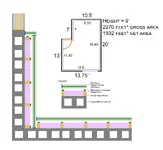D
davidcatpi
New member
Hi, I want to turn a medium bedroom into a live room. Walls can only be treated in the interior of the room. Existing window must be kept and treated too.
This is the room shape, it's dimensions with a wall design that I keep seeing around in the web, with how "I think" corners must be dealt with.

I went to Bob Golds Room Mode Calculator and it looks like it can actually work. (using 8 feet height)
I still need to figure out floor/ceiling treatment, window/door treatment.
I'm a noob, when it comes to soundproofing and acoustic treatment, is this making any sense?
This is the room shape, it's dimensions with a wall design that I keep seeing around in the web, with how "I think" corners must be dealt with.

I went to Bob Golds Room Mode Calculator and it looks like it can actually work. (using 8 feet height)
I still need to figure out floor/ceiling treatment, window/door treatment.
I'm a noob, when it comes to soundproofing and acoustic treatment, is this making any sense?
Last edited:
